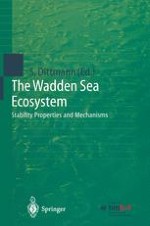1999 | OriginalPaper | Chapter
Stability Properties in the Wadden Sea
Authors : Volker Grimm, Hauke Bietz, Carmen-Pia Günther, Andreas Hild, Marlies Villbrandt, Verena Niesel, Ulrike Schleier, Sabine Dittmann
Published in: The Wadden Sea Ecosystem
Publisher: Springer Berlin Heidelberg
Included in: Professional Book Archive
Activate our intelligent search to find suitable subject content or patents.
Select sections of text to find matching patents with Artificial Intelligence. powered by
Select sections of text to find additional relevant content using AI-assisted search. powered by
To achieve an understanding of the processes and mechanisms responsible for the reaction of the components of the Wadden Sea to disturbances, an attempt is made to assess the stability properties of the components studied by ELAWAT. It is discussed how this assessment depends on the choices of the variable of interest, the scale of observation, the type of disturbance, and the identification of the reference dynamics. The assessment shows that the components of the Wadden Sea possess certain stability properties: both biotic and abiotic components exhibit low constancy or high variability at small spatial and temporal scales, constancy (as well as resilience in the case of disturbances) at intermediate time scales of years to several decades and spatial scales of entire tidal flats, and persistence under natural conditions at temporal scales of many decades to centuries and for the entire Wadden Sea (or large parts thereof). Among the most important stability mechanisms of the organisms living in the Wadden Sea are their high taxonomic or functional diversity, their mobility and their high potential population growth rates. Benthic organisms may react to disturbances via “resilience in-situ” or “resilience by migration”. However, the natural, tide-driven web of abiotic processes must continue to persist if the stability mechanisms of the organisms in the Wadden Sea are to unfurl.
